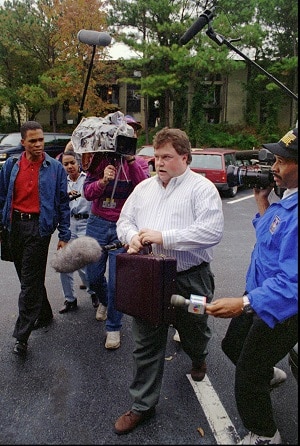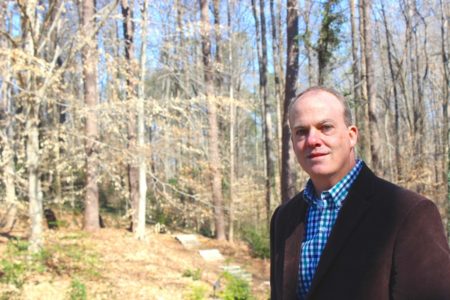Around these parts, Alan Mothner is best known as the longtime executive director of the Dunwoody Nature Center, which programs a beloved local park. But in the 1990s, he had a very different career as a news photographer on the story of a terrorist’s bombings of the Olympics and other metro Atlanta sites. In 1997, he was within 30 feet of a bomb when it exploded outside a Sandy Springs abortion clinic, and took dramatic photos that were published around the nation.
“It was one of those fight-or-flight moments… I decided to do what a good journalist does, which is run toward the explosion,” Mothner recalled in a recent interview.
He also shot the immediate aftermath of the 1996 Olympics bombing and joined the media stakeout at the Buford Highway home of Richard Jewell, the heroic security guard turned bombing suspect who is now the subject of an upcoming Clint Eastwood movie. And his final big news assignment before leaving the journalism business? Covering the 2003 arrest in North Carolina of the real bomber, Eric Rudolph.

Today, Mothner still lives in Dunwoody, his home since 2003. After stepping down from the Nature Center earlier this year, he runs a consulting firm called Town Square Collaborative. The following are some memories he shared of his role in covering Rudolph’s campaign of terror.
An Olympus and the Olympics
In 1995, Mothner was working in advertising and marketing when he fell into photography by chance.
“My grandfather passed away and left me his old Olympus camera that was all manual,” he said. He took a class at Atlanta’s Callenwolde Fine Arts Center to learn to use it. When his work got a good reception, he began freelancing for such publications as Creative Loafing and 30306, the original name of the Reporter’s sister publication Atlanta INtown.
By early 1996 – the year Atlanta hosted the Summer Olympics – Mothner was freelancing for such major outlets as the Associated Press and the Atlanta Journal-Constitution, shooting breaking news by day and sports events at night. In the pre-digital era, sending the photos in for publication could be quite a feat; he recalls using “what we called a road warrior kit,” a portable lab the size of a toaster oven where photos could be developed on paper, then run through a suitcase-sized scanner for transmission.
At the time of the Olympics, Mothner was rooming in Buckhead, having been temporarily booted from his Lake Claire home by a landlord bringing in higher-paying tourists attending the Games. He was not assigned to shoot any of the sporting events, instead covering other news in the city or Olympics-related activities outside the venues.
In the early morning of July 27, Rudolph set off a shrapnel bomb in Centennial Olympic Park during a crowded concert, killing one and injuring many more. Mothner got notified the way one did back then – by pager.
“So the night of the Olympic bombing, it was all hands on deck,” he said.
Rushing to the scene, he joined the regular stable of photographers already assigned to the Games. Most of his work that night, he said, was photographing the reaction of people on the street.
Richard Jewell
Jewell discovered the bomb in the park and helped to warn many spectators away from the danger before it exploded. But he quickly became the FBI’s favored suspect, and when the AJC revealed that fact, a media frenzy ensued.
Jewell was living with his mother in an apartment at 3694 Buford Highway in what is now the city of Brookhaven, in a complex then called Monaco Station and now Sierra Gardens. Many reporters staked out the home, hoping to get an interview or photos.
“With Richard Jewell, there was essentially a 24-hour watch with media on him,” said Mothner, recalling that NBC News rented a nearby apartment for reporters and crew to live in for the duration. “It was wild.”

Mothner was among them, sent by AP repeatedly. “I was there for maybe a week straight. Sometimes I hung out with the NBC guys in their apartment,” he said. Among the shots he got was Jewell heading out on the day he was officially exonerated of the bombing by federal prosecutors.
“I remember one funny story,” Mothner said. “The door [of Jewell’s apartment] opens and everybody rushes the stairs, and I believe it was his mother [who] came out. And she’s like, ‘Y’all need to get away from the stairs.’
“And she’s rightfully angry. As poorly as the media’s portrayed, that was exactly correct for what was occurring there. And we were all just trying to do our job, obviously, but it was not a pretty scene.
“And so no one’s moving, and she comes out with this Doberman and she’s like, ‘He’s a little itchy and you might want to get out of the way.’ And you never saw a path clear so fast in your life. ‘Yes, ma’am! All the space you need!’”
The Sandy Springs bomb
Rudolph struck again on Jan. 16, 1997, when he bombed the abortion clinic at 275 Carpenter Drive in Sandy Springs. Mothner, then living in Brookhaven, got a call from his bosses at AP to go check out the report of an explosion. He recalls that at first there was not much visible damage and little to photograph. No one knew that Rudolph was using a diabolical new tactic of setting off a secondary, delayed bomb with the intent of murdering first responders.
“There really wasn’t a lot going on until the second bomb went off, and then all hell broke loose,” Mothner said.
The second bomb was hidden inside a dumpster enclosed in a wooden fence. Mothner says he was about 20 to 30 feet away when it exploded.
“It was really, really loud,” he said. “… I was covered in debris, mostly wood, from the explosion.”
But, aside from temporary ringing in his ears, he was uninjured. So he started taking photos that captured the bomb smoke still rising and injured and dazed officers on the ground.

“I was right there. So after the shock wore off of what had just happened, it was pretty obvious what had happened, so I just turned and started shooting,” he said.
“You’re there doing your job, so you don’t think of, ‘Oh, a second bomb went off. I wonder if there’s a third bomb? I should go get in the car and drive home’…,” he said. “Once the, for lack of a better term, the excitement of what happened wore down … there was that ‘holy crap’ moment. ‘Holy crap, I just got bombed during the assignment!’”
He said authorities examined his photos and made copies of the negatives for evidence. His bosses at AP circulated the photos around the world — then, in typical journalism glamor, sent him right back out to cover an Atlanta Hawks game that night. He said they paid him a $500 bonus for the bombing shots.
The end of the road
Rudolph went on to bomb an Atlanta LGBTQ bar called the Otherside Lounge and an abortion clinic in Alabama, killing one and injuring more, before he was identified by authorities and became a fugitive in the North Carolina mountains. After years on the FBI’s Ten Most Wanted list, he was arrested in Murphy, N.C., in 2003 and is now serving a life sentence in federal prison.
The Reuters news agency sent Mothner to North Carolina to cover the arrest. “He became kind of like legendary in a certain respect, like an outlaw,” Mothner recalled of some local perception of Rudolph. Mothner said he had no personal desire to see the end of the road for the terrorist who set off a bomb near him. In fact, he found it to be “not an exciting assignment” because it was all press conferences.

There was one big reason to send a photographer, Mothner said: “No one had a photo of him yet.” And Mothner did not get that shot of Rudolph being led from jail in chains. Tired of waiting and with a 2-year-old child at home, Mothner headed back to Dunwoody.
Mothner continued in commercial photography for a while, but soon left photojournalism behind due to the time demands and dwindling pay in the digital era. “I don’t miss any of the photography,” he said.
But he’s eager to see Eastwood’s take on the bombing story in the film “Richard Jewell,” which is scheduled for release on Dec. 13.
“The scenes that I keep seeing in the previews for the movie seems like so accurate,” said Mothner about a clip showing the old Buford Highway media stakeout. “It is exactly as I remember it, even the parking lot of the apartment complex and the crape myrtles that are there, and the photographers… They really captured them. I’m really looking forward to seeing the movie.”

